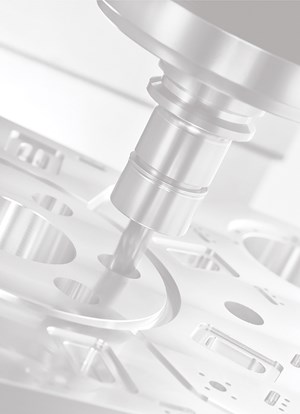Siemens CNC Control Enhances Shopfloor Productivity with Robot Integration
Siemens Digital Industries' Sinumerik 828 CNC seamlessly integrates with KUKA robots for cost-effective part handling and automation in job shops.
Share



Siemens’ Sinumerik 828 CNC control for multitasking job shops is capable of integrating to work in tandem with a KUKA robot to simplify operation and programming for part handling.
Key advantages of this integration include:
- Integrating the robot’s programming and operation into the Sinumerik 828 control, with everything accessible on one screen
- Using NC G-code and a robot teach-in function for programming, making it straightforward for machine tool operators
- Displaying robot diagnostic data on the NC’s diagnostic screens, enabling monitoring of the entire automation cell
- Testing robotic integration in the Sinumerik 828D’s digital twin software while cutting.
This solution offers a cost-effective approach to robot integration by incorporating KUKA robot functionality with machine tools such as the SYIL brand of machining centers and lathes, suitable for small- to medium-sizedjob shops.
Tiansu Jing, product manager for Sinumerik CNC systems at Siemens, explains that setup, programming, operator interface and diagnostics are all improved with this system. The teach-in functions are implemented through the Sinumerik Operate system on the control, while the Sinumerik RunMyRobot capability seamlessly integrates with the KUKA robot control. Jing adds that since there is no need to learn robotic programming, start-up time is reduced, and the separate robot control pendant is eliminated, simplifying the operator’s task. The Sinumerik CNC’s human-machine interface (HMI) operates both the machine tool and the robot.
The robot arm is fully integrated into the CNC, enabling programming, operation and diagnostics for both the machine and the robot on a single control. Robot and part programs are resident in the CNC and accessed through the Sinumerik Operate graphical user interface. Robotic functions such as programming, manual travel, teach-in and diagnostics are directly executed from the CNC. All functions can be monitored on a single pendant, eliminating the need for a second robot pendant.
Additionally, robotic fiber placement and 3D printing support advancements in manufacturing processes through Industry 4.0, the digital twin, enhanced robotic intelligence and complex motion control, according to Siemens.
Related Content
-
10 Robotic Solutions You Can Find at IMTS 2026
Discover how today’s robots and cobots are making it easier than ever to automate tasks, free up skilled workers, and run machines unattended – even in small and midsized shops.
-
Setting Up the Building Blocks for a Digital Factory
Woodward Inc. spent over a year developing an API to connect machines to its digital factory. Caron Engineering’s MiConnect has cut most of this process while also granting the shop greater access to machine information.
-
Addressing Manufacturing Challenges with Automation
GrayMatter Robotics’ Physical AI robotic cells for manufacturing offer immediate impact and results.
















